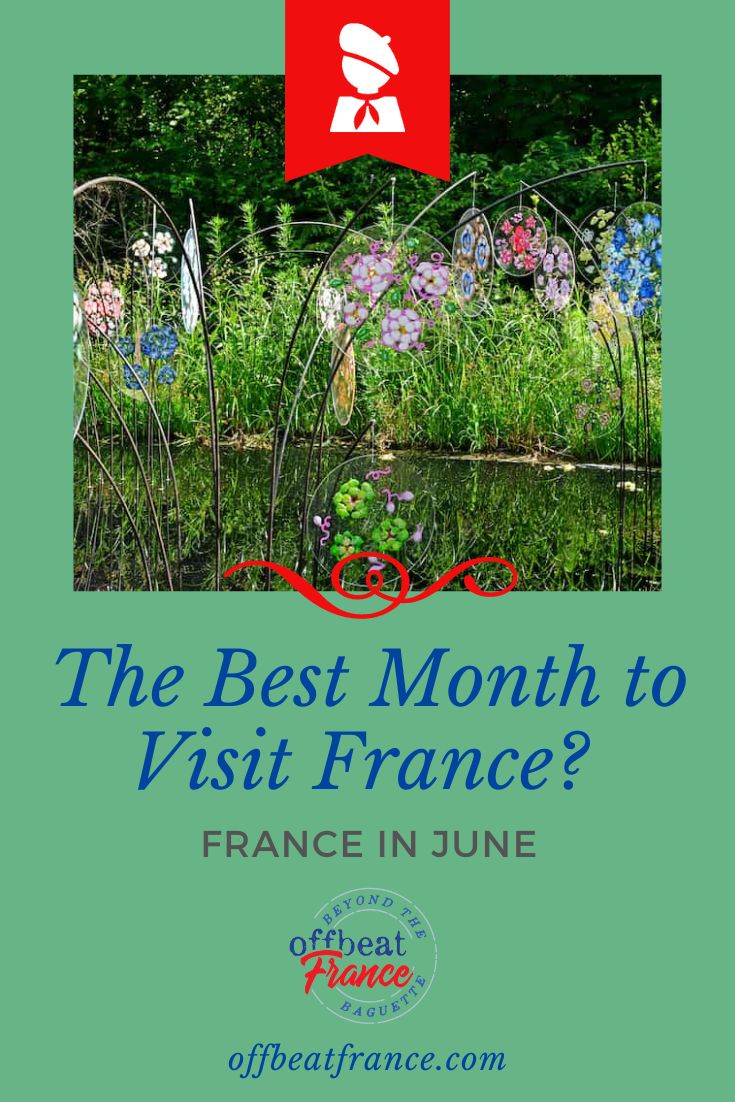Unsure about your French table manners? Click Here to download > > How to avoid these 10 food etiquette mistakes !
- Home ›
- Plan Your France Trip ›
- France in June
France in June: 10 delightful destinations for early summer
Updated 23 May 2025 by Leyla Alyanak — Parisian by birth, Lyonnaise by adoption, historian by passion
France in June is a delight: the weather is warm, verging on hot, but things aren't as crowded as they're about to become. You can still feel the end of spring, and it's one of my favorite times to travel cross-country.
France weather in June is extraordinary, at its best across the country − so you’ll have your work cut out trying to decide where to go!
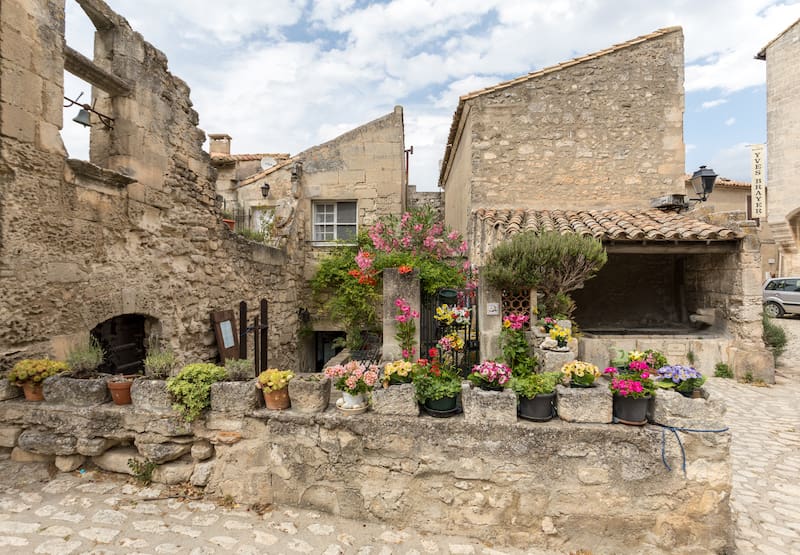
I’ve tried to narrow it down for you, from the stunning perched hilltop villages of Provence to beaches that never end and cool green mountains filled with hiking trails and stunning views.
Here, then, are my personal recommendations for 10 best places to visit in France in June – and based on my own experience!
NOTE: Pages on this site may contain affiliate links, which support this site. See full Privacy Policy here.
What is France June weather like?
What are the 10 best places to visit in France in June?
- 1. Arles and the Camargue
- 2. The Ardèche
- 3. Annecy and the Haute-Savoie
- 4. Avignon
- 5. Luberon in Provence
- 6. Nice and French Riviera
- 7. The Basque Region
- 8. Loire Valley
- 9. Lyon
- 10. Paris
A few bonus places to visit in France in June
What is France June weather like?
France is a large country, almost the size of Texas, so the weather on the Riviera won’t be the same as in Brittany.
Still, the weather in France in June is by and large agreeable, with plenty of sunshine, warmth (without the searing heat of summer) and less rain than in previous months, but some rain nonetheless, about a quarter of the time and sunshine on an average of 19 days.
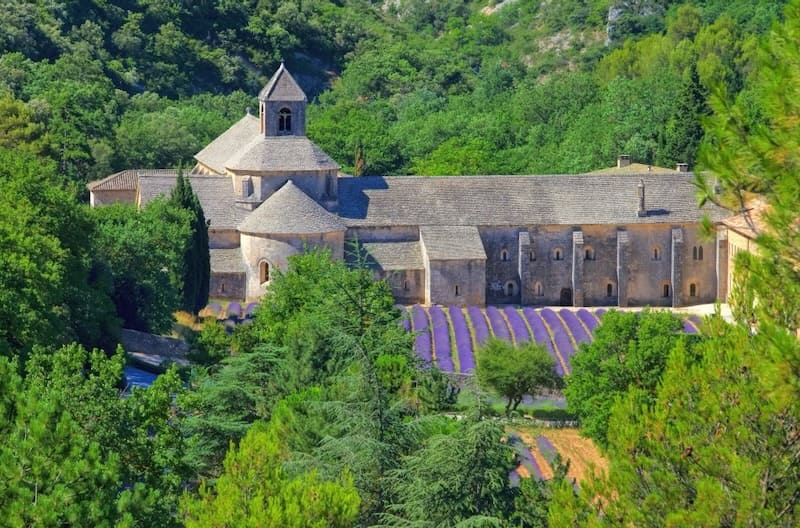 France in June at its best - a view of lavender fields at the Abbey of Senanque
France in June at its best - a view of lavender fields at the Abbey of SenanqueDuring the day, you’re looking at average temperatures of 25-27℃ (around 80℉), dropping to around 15-16℃ (around 60℉) in the evening in most the country, but temperatures can vary widely depending on whether you’re inland or on the coast − make sure you check the local weather forecasts where you are.
In the northern part of France, from Paris onward, you’re looking at mild temperatures and the possibility of rain, with lower and rainier weather in Brittany and Normandy, but still, this is when you’ll get some of the best weather in the region.
In Central France, around the Loire Valley, you’ll also have warm, sunny skies and the further south you go, towards Provence and the French Riviera, you’ll be looking at even warmer, dryer weather.
If you’re taking your France holidays in June, there aren’t any regions you’ll have to avoid!
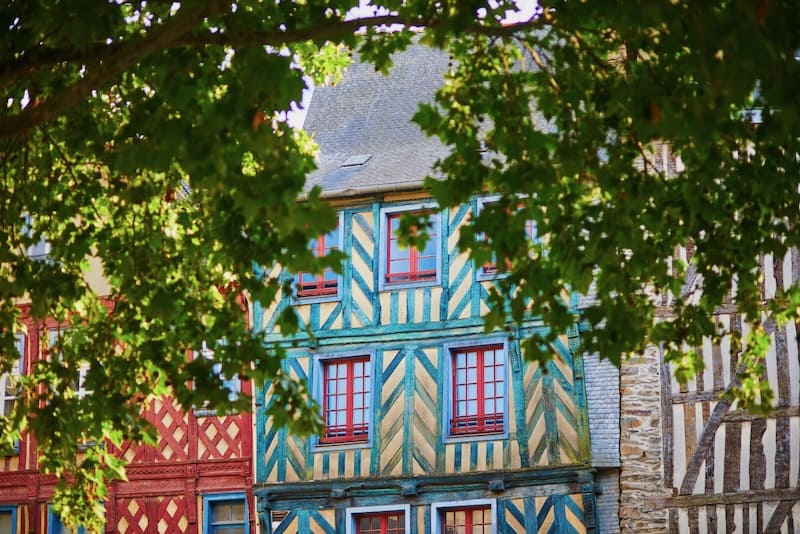 Half-timbered houses in the town of Rennes, in Brittany
Half-timbered houses in the town of Rennes, in BrittanyWhat are the 10 best places to visit in France in June?
So we’re agreed, June is ideal pretty much everywhere in the country.
Whatever the time of year, France has beauty, it has history and culture, and it has delectable cuisine, and it certainly is a country on most bucket lists. But June is a particularly stunning month to visit, with warm weather, longer days, and not as many crowds as you’d find in July and August.
The beaches open up, cafés are full, and everyone is outside, eating on terraces. I live in France, and for me June is one of the most beautiful months my country has to offer.
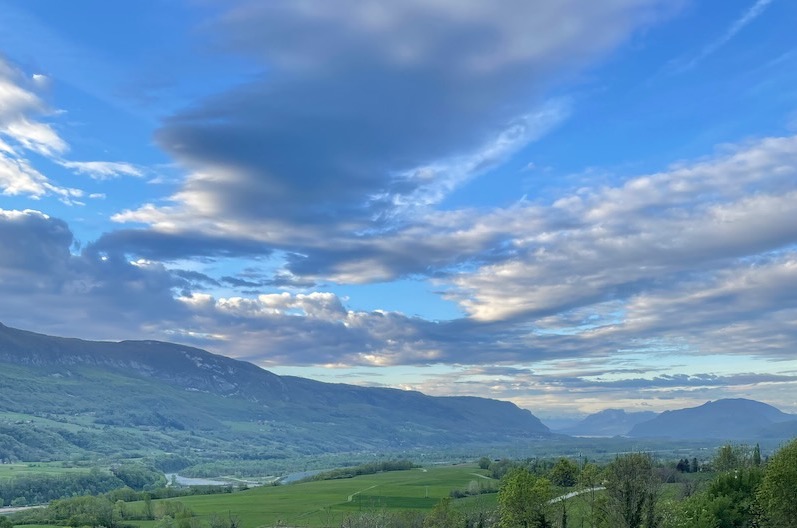 The view from my window: this is what I see when I'm at my desk, with a sliver of the Rhône River on the left, and in the distance, the Lac du Bourget
The view from my window: this is what I see when I'm at my desk, with a sliver of the Rhône River on the left, and in the distance, the Lac du Bourget1. Arles and the Camargue
The Camargue is one of my favorite regions of France, a combination of wild nature, beautiful sea and historical Roman ruins.
The jumping-off point for the wetlands of the Camargue is the Roman city of Arles, whose vestiges are remarkably well-preserved (and there are many of them). If you’re fascinated by Rome, the city has an incredibly rich museum of antiquities that will hold your attention for hours.
And let’s not forget the latest addition to the city – the Luma Arles, an artistic complex housed in an artful metallic building designed by architect Frank Gehry.
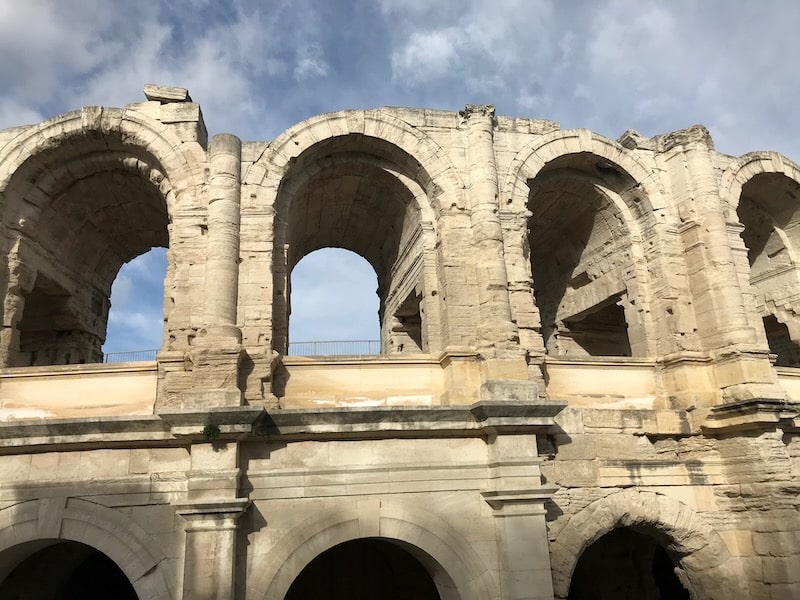

From Arles, it’s a stone’s throw to the Camargue, one of the last untamed areas of France. It’s a land of wild horses and salt marshes and bursting colors in June.
Go horseback riding in one of the many ‘manades’, where bulls and horses are raised, or birding at the Parc Ornithologique du Pont de Gau. You won’t see the flocks of lovelorn pink flamingos that dance through February, since in June they shed their pink plumage for a quieter, grayer shade.
No matter – the park is on a migratory route so you’re bound to see plenty of other birds, like herons.
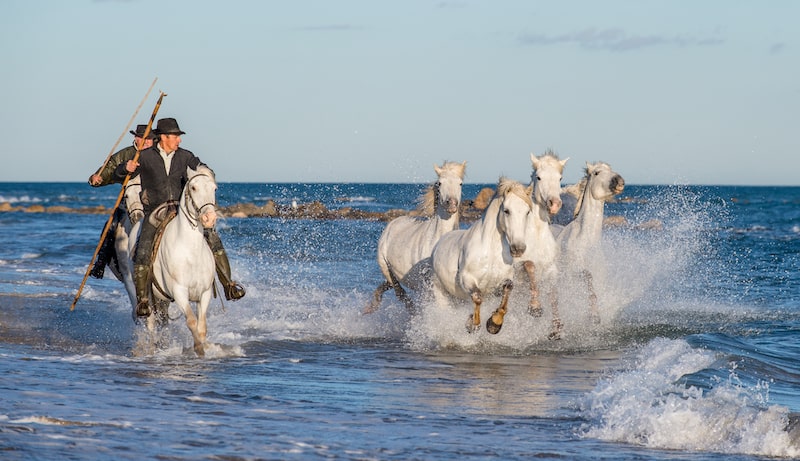
Nature here is gentle, with marshes and waters and summer breezes you can experience on foot, by bike, by horseback or on a boat.
The Camargue extends to the Mediterranean and in June, early summer will make eating in one of the outdoor restaurants a joy, with the waves splashing in the background.
Several lovely towns dot the Camargue: Saintes-Maries-de-la-Mer, with its whitewashed buildings and 9th-century church with its Black Virgin; Aigues-Mortes and its ramparts around the town; and Grau du Roi, a charming fishing port whose boats unload their catch right on the wharf.
I’ve visited the region at least five times and I’m still enchanted, every single time.
🌻 🌻 🌻
2. The Ardèche
If what you’d like is more of France’s wild side, the Ardèche is even wilder than the Camargue − so wild that it is the only départment in France not to have a single train station!
Yet.
Because plans are afoot to bring the Ardèche into the next century, which many people deplore.
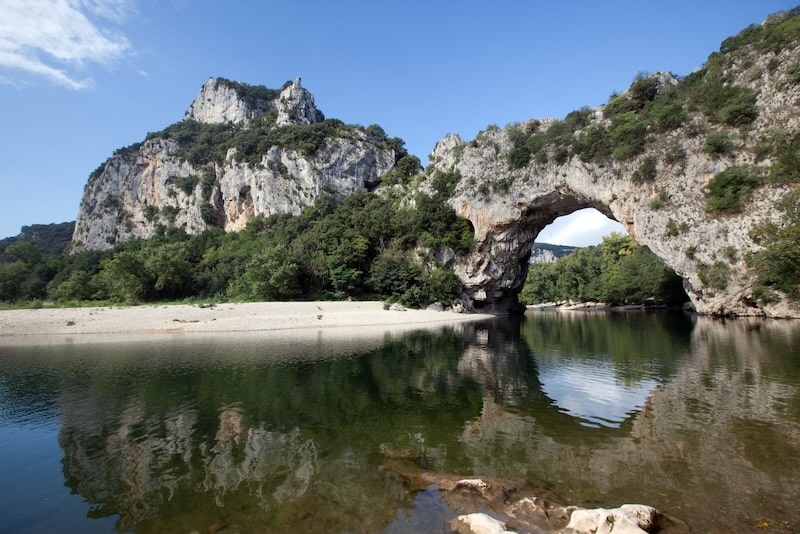
This little bit of France is known for its natural beauty and dramatic landscapes, with deep gorges cut by fast-flowing rivers, perfect for canoes and kayaks.
This is home to the Pont d’Arc, a limestone arch that spans the Ardèche River, and the Ardèche Gorge, iconic natural formations that are trademarks of the region.
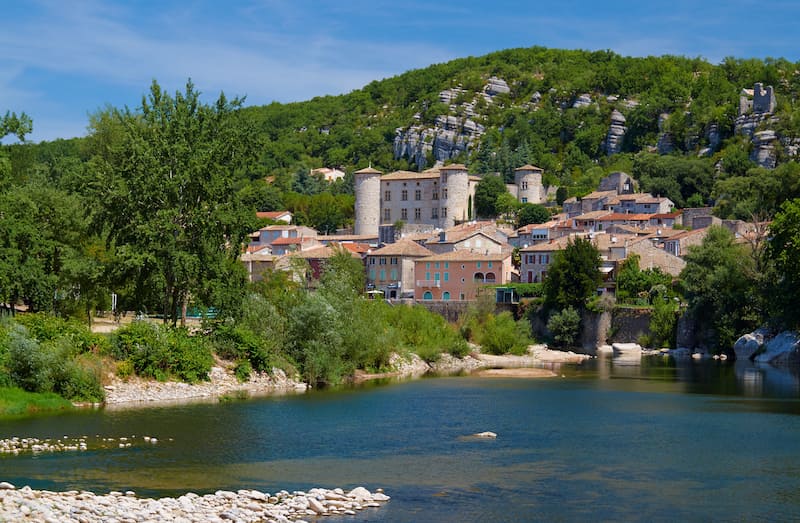
The Ardèche is also home to plenty of picturesque medieval villages, like Balazuc and its narrow, winding streets and stone houses; Vogüé, a beautiful hillside village known for its 12th-century castle; or Labeaume, with its strangely shaped cliffs.
Possibly the best-known attractions of the Ardèche are some of the unique prehistoric caves of France, such as the Aven d’Orgnac or Chauvet-Pont d’Arc.
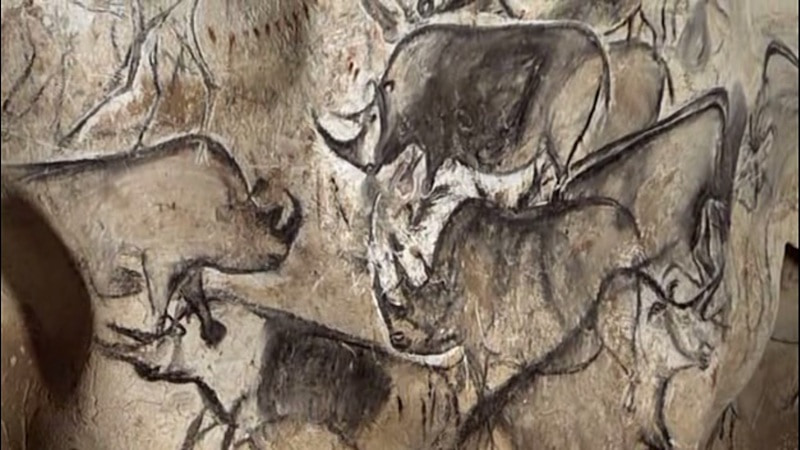
And by the way, the Ardèche is world-renowned for its chestnuts!
🌻 🌻 🌻
3. Annecy and the Haute-Savoie
What I love about Annecy in June is the flowers. A beautiful city at any time, by June every flower box in the city – and there are many – are overflowing. Annecy happens to be known as the “Venice of the Alps”, its series of small canals floating along cobblestoned and arcaded streets.
Right in the center of town is Lake Annecy, with its sparkling blue waters – Europe's cleanest, just waiting for you to jump in. The bike path around the lake is now complete, and on a warm June day you’ll see parachutes floating above your head, swirling down the mountain currents.
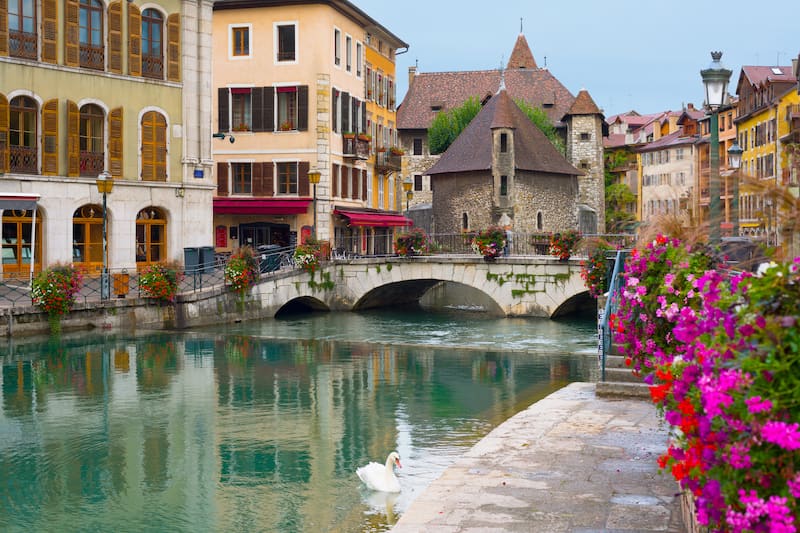
Above the lake, you can see the French Alps, with their perfect summer hiking trails and exciting cable cars, like the Aiguille du Midi in Chamonix, which takes you up the Mont-Blanc.
I would recommend Mégève and Morzine as well, and Abondance (try to go on a Sunday when the weekly market takes place and buy some fresh, world-class Abondance cheese).
While you’re here, two more delightful villages are worth a visit: the tiny medieval town of Yvoire, on the shores of Lake Geneva, and Evian-les-Bains, where Evian water was born.
If you plan on spending several days in the region, this 5-day Lake Geneva itinerary might be just the thing.
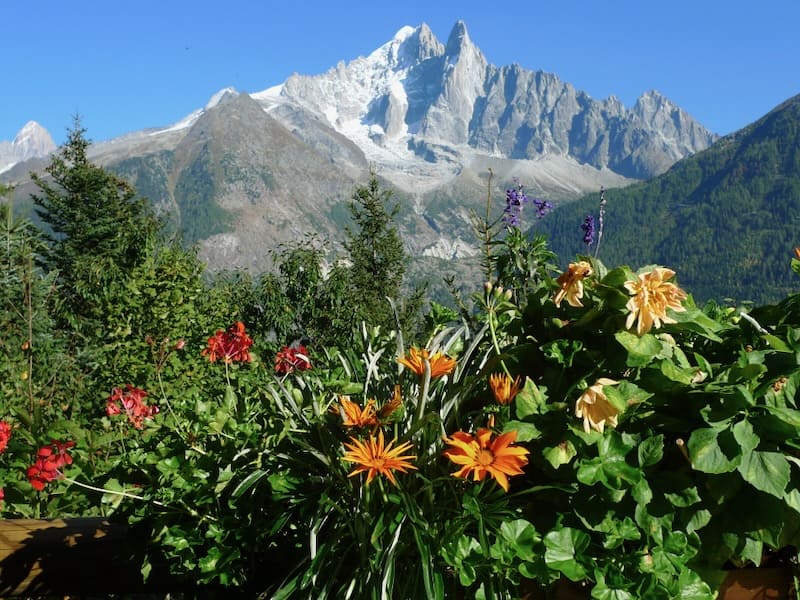
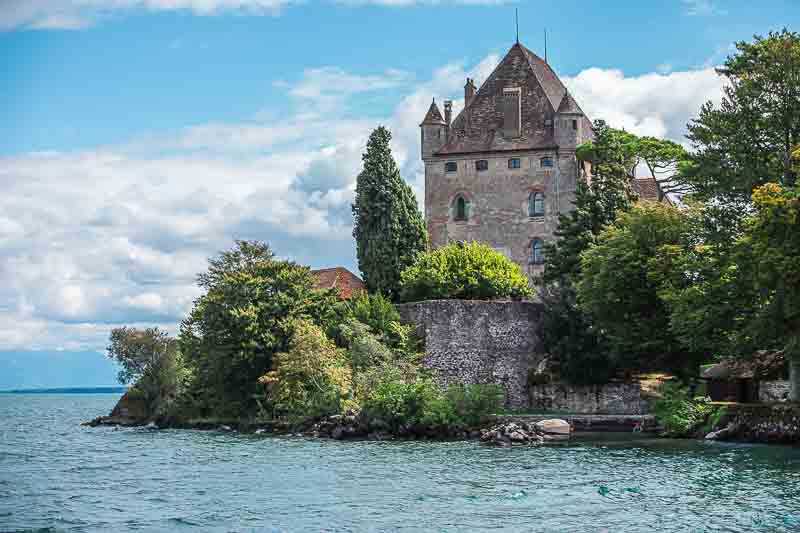
🌻 🌻 🌻
4. Avignon
Southern France is wonderful in June and Avignon is its gateway. The city is famous for its Palace of the Popes, a UNESCO World Heritage Site and former papal palace. Walking around Avignon is a pleasure, especially down the Rue des Teinturiers, with its ancient functioning waterwheels and the many tiny theaters that line it.
Theater is a hallmark of Avignon and in summer, the Avignon Festival takes over the town, starting at the end of June and stretching into July. It is one of France’s most important cultural events, with performances in dance, music, theater and plenty of cultural events, turning the city into a buzzing center of culture.
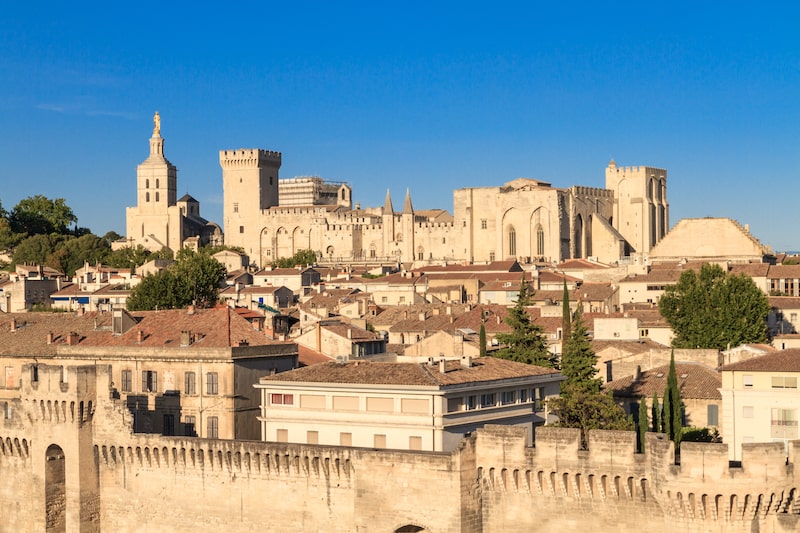
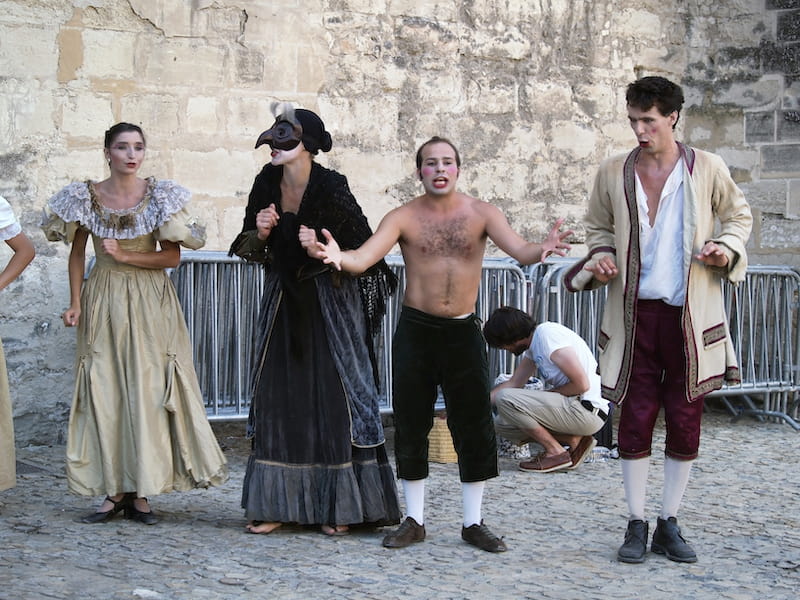
The city is also famous for Avignon Bridge, one of the first songs any French child learns.
If you’re planning on visiting the Luberon, and you should, Avignon is the perfect base from which to explore. You can reach Avignon easily from Paris on the TGV but if you plan to explore more of the region, then rent a car in Avignon first. There’s very little public transportation in the Luberon.
🌻 🌻 🌻
5. Luberon in Provence
After Avignon, the Luberon should be your next stop. If the name isn’t familiar, you’ll certainly remember those gorgeous medieval hilltop villages that were so photogenic when postcards were available on every corner? Provence in June is heavenly.
The region is so beautiful it has been immortalized by many artists. For example, Van Gogh painted many local scenes and landscapes in the times he lived in Provence.
Five Luberon villages are part of the official list of Most Beautiful Villages in France (yes, there is such a list!), and no one will quibble. You may have heard of one of them, Ménerbes, made famous by Peter Mayle’s A Year in Provence.
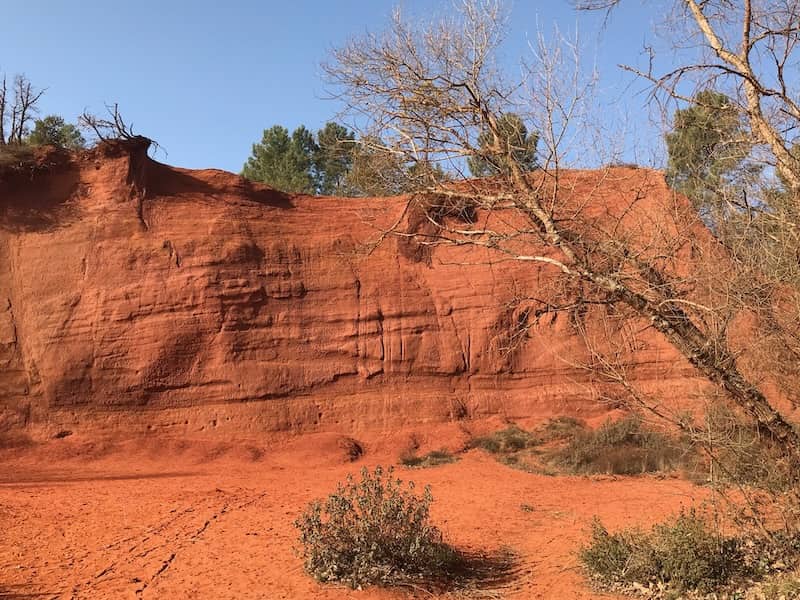 The ochre hills of the Luberon
The ochre hills of the LuberonAnd you may have seen photographs of Gordes, with its masonry walls (a building technique protected by UNESCO), or the castles of Lourmarin and Ansouis, or the ochre village of Roussillon, where the buildings look like they’ve been painted in gold.
And just because a village isn't on the "Big Five" list doesn't make it any less beautiful, as you'll see if you visit authentic villages like Bonnieux or smaller, restored ones like Lacoste, once home of the Marquis de Sade.
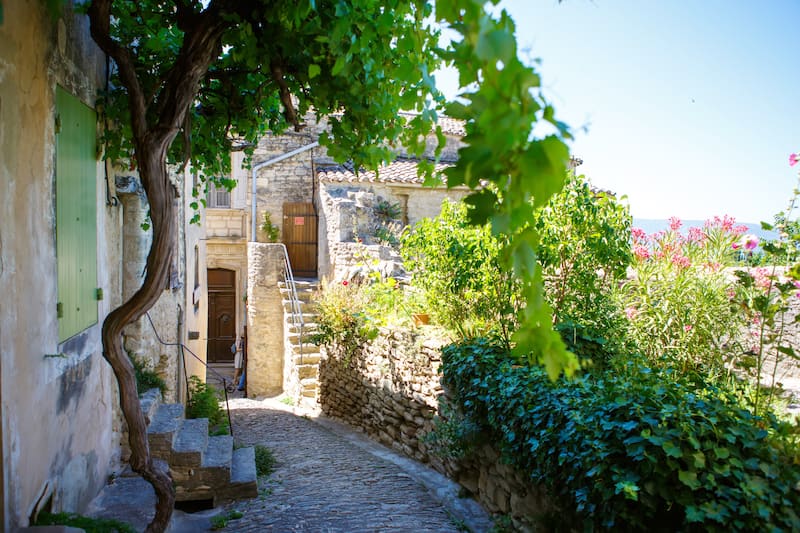
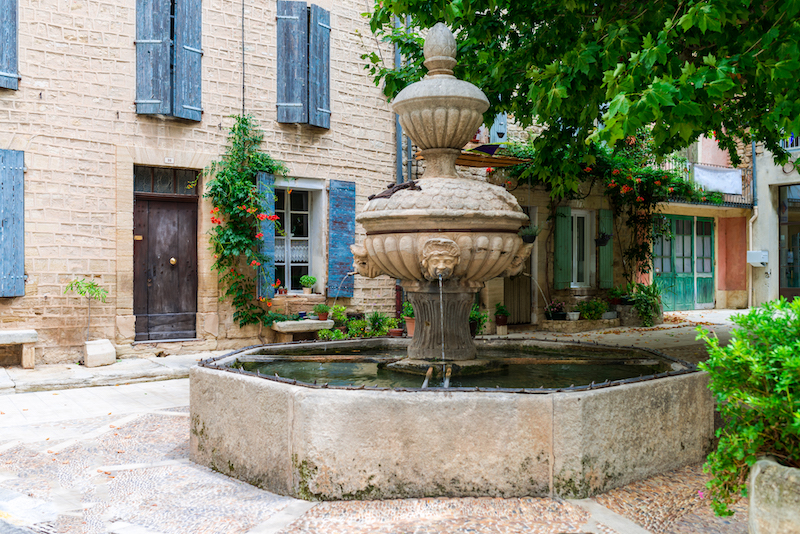 A charming square in Ansouis
A charming square in AnsouisRoman ruins, medieval castles and ancient churches – the Luberon has it all. The gentle hills of the region are perfect for hiking or cycling.
June is a special month here: it is lavender season, when the fields are in bloom, the waves of purple flowers undulating as far as the eye can see − and the nostrils can smell. Head for the Valensole Plateau, where they are most concentrated, but frankly, anywhere you drive between villages will be lined with lavenders.
🌻 🌻 🌻
6. Nice and French Riviera
Just south of the Luberon is the French Riviera, impossibly crowded and hot in July and August but wonderful in June, before vacationers descend and prices skyrocket.
Nice is the main city in this part of France, perfectly positioned along the graceful Baie des Anges. In June, take advantage of the seaside cafés for lunch, before the hot months of July and August arrive. You can then take a dip in the water…
Nice is also filled with excellent museums dedicated to artists like Matisse or Chagall.
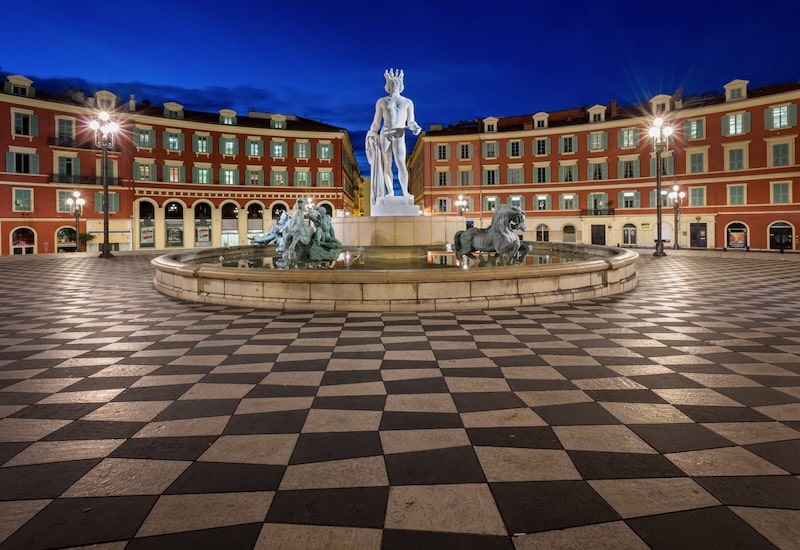
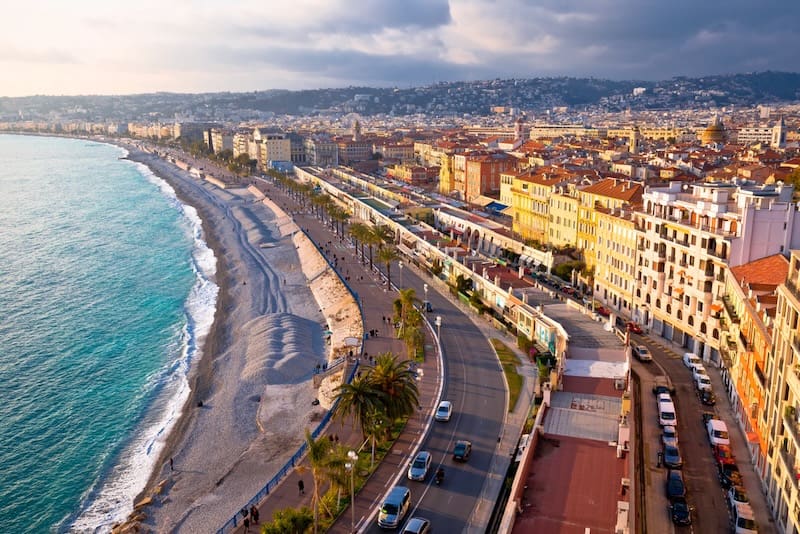
The city is rich in so many ways − fabulous Mediterranean food, a wonderful market and antique shops, and winding colored streets in the old town. Admire the Belle Epoque architecture of the Negresco Hotel along the 7km Promenade des Anglais.
Beyond Nice, you must visit other dazzling towns of southern France, like the coastal Antibes or Cannes. Off the Cannes coast you’ll find the Lérins islands, one of which once housed the Man in the Iron Mask, the real one. You could push to Menton, near the Italian border, with its ochre and rust-colored buildings.
A lovely village is Villefranche-sur-Mer, just outside Nice, a quiet haven filled with good restaurants and a lovely walk along the water. Nearby is the Villa Ephrussi de Rothschild, with its stunning gardens and eclectic Belle Epoque furniture (the house belonged to Baroness Béatrice de Rothschild).
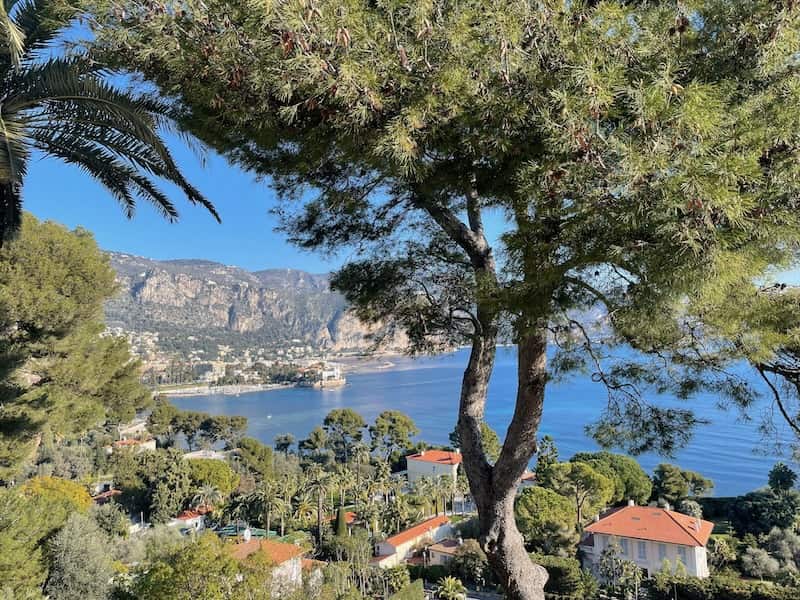
While the region has some of the best beaches in France in June, head inland to Èze or Saint-Paul de Vence for medieval villages filled with art and cobblestones. And please, don’t neglect Grasse, the perfume capital of the world. It’s lovely and you’ll learn plenty about perfume.
🌻 🌻 🌻
7. The Basque Region
The Basque region is in the southwestern corner of France, on the border with Spain, one of the seven Basque provinces (three are in France, four in Spain).
Visiting the Basque region is like going abroad without leaving France. It has a distinct regional architecture and its language is unknown anywhere else in the world other than over the border in Spain.
You can start by exploring its capital, Bayonne, and work your way down the coast with this Basque itinerary before heading into the interior.
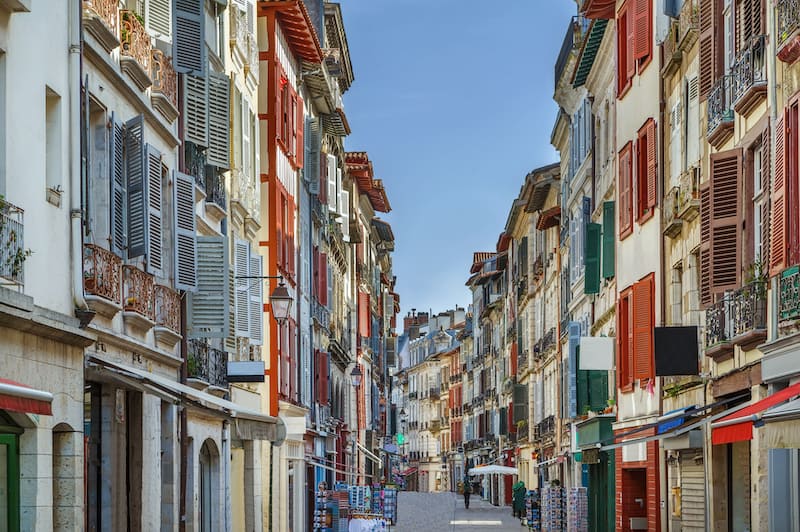
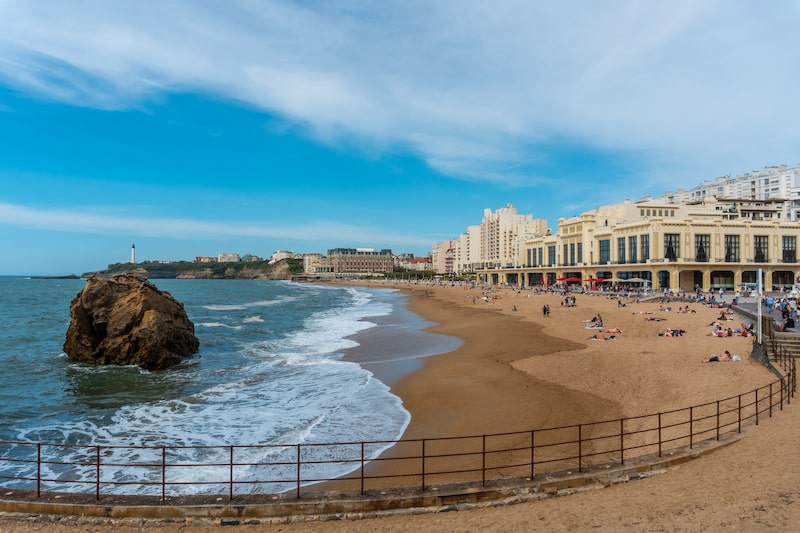
The region has it all: popular beaches, some of which, like the stylish Biarritz, became famous as playgrounds for Emperor Napoleon III and his wife Eugénie – and now world-renowned for surfing; fishing villages, like Saint-Jean-de-Luz, that retain their authentic charm; or Bidard, with its traditional Basque architecture.
You’ll find even more Basque architecture in the interior, in such “listed” villages as Sare or Ainhoa.
Let’s not forget the Basque reputation for cuisine – its chefs are some of the best in the world. The Basque region even has its own chilli, the “piment d’Espelette”, and you can visit the village of Espelette and enjoy the strings of peppers laced across many of the façades.
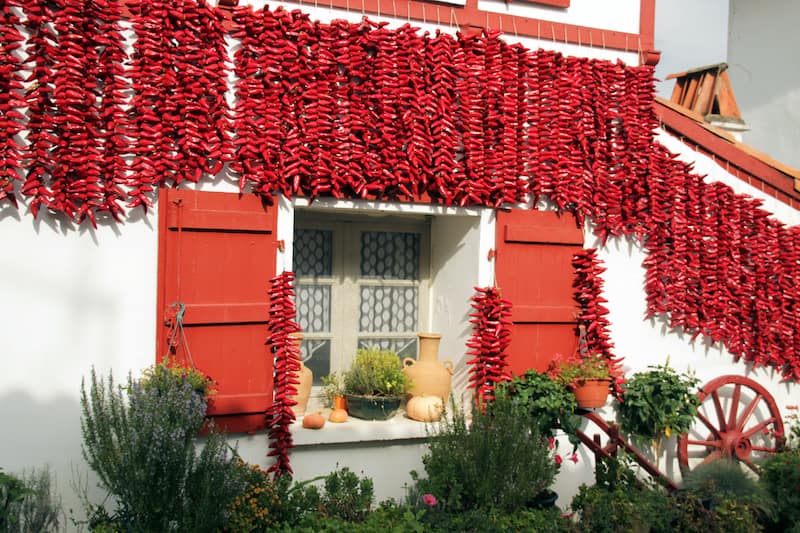
This is an incredibly diverse region, where in half an hour you can go from a surfing beach to quaint villages to green mountain valleys.
If you’re headed off to walk the Camino, your journey might well start in Saint-Jean-Pied-de-Port, the jumping off point for the so-called “French Route” across into northern Spain.
June is a mild season in this region, with plenty of sunshine – there will inevitably be some rain, but the rainy season is over and everything is fresh and green.
🌻 🌻 🌻
8. Loire Valley
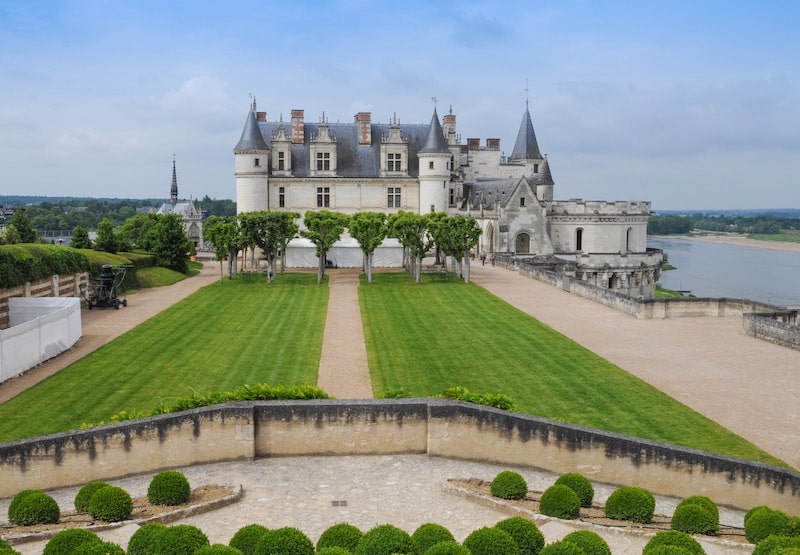
The Loire Valley is world-renowned for its more than 300 castles, and whoever says castles, says gardens. In June, flowers and plants are fresh and colorful, and haven’t been wilted by the summer sun.
Some of the castles have extraordinary gardens, geometrically perfect as though cut by a razor blade. Others are wild and tangled, but equally spectacular, and perfect if you want to sit outdoors and have the kind of picnic the French do.
We all have our favorite castles, right? I have several, but at the top of my list is Chenonceau, also known as the Ladies’ Castle. Others topping my list include Azay-le-Rideau, Amboise and Chaumont – which, by the way, hosts a fabulous international garden festival each year. Chinon is stuffed with history, from Joan of Arc to the Templars.
Perhaps the most famous are the gardens of Villandry Castle, breathtakingly organized and perfectly maintained.
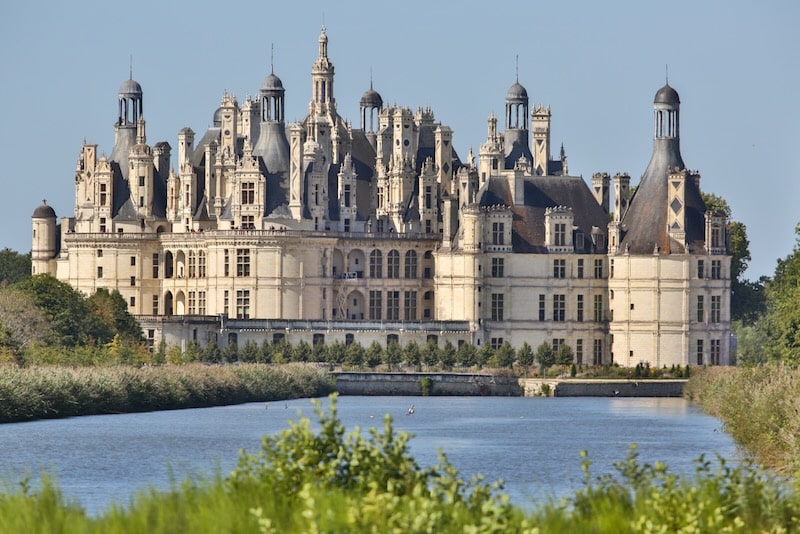
The Loire is also a wine-producing region and a drive through the vineyards could be a great tasting experience of Sancerre and Pouilly-Fumé. Cycling is easy in this part of the country, especially along the banks of the Loire and Cher rivers.
One of delights of the Loire Valley is its proximity to Paris: even if you’re only staying a short while, you can still take a day trip to the Loire Valley.
Once here, you can visit the region’s many troglodytic dwellings, built right into the hillsides. Some have been converted into restaurants or hotels, like the Troglododo in Azay-le-Rideau. Or for a different point of view, take a hot air balloon ride over some of its most beloved chateaux.
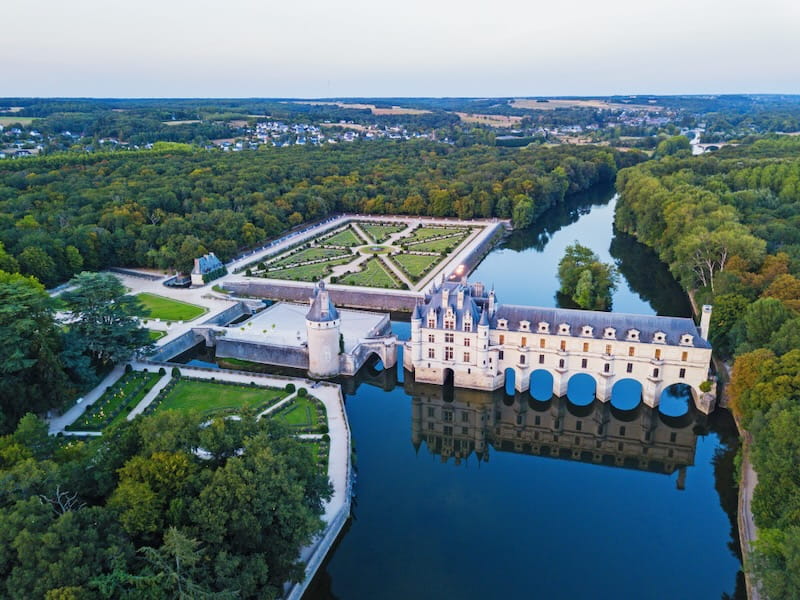 A view of Chenonceau from a hot air balloon
A view of Chenonceau from a hot air balloon🌻 🌻 🌻
9. Lyon
Have you ever visited France’s second-most buzzing city? I’m talking about Lyon, although it does vie with Marseille when it comes to size and population.
Even though it is relatively north of Provence, it can get very hot in summer, which is why June is such a lovely month for a visit (not to mention that prices are also lower).
Lyon was once the capital of Gaul, so you’ll find plenty of Roman ruins and an excellent Roman history museum. It also has world-class art, and sits at the confluence of two major rivers, giving it not two but four riverbanks along which to walk or sip coffee.
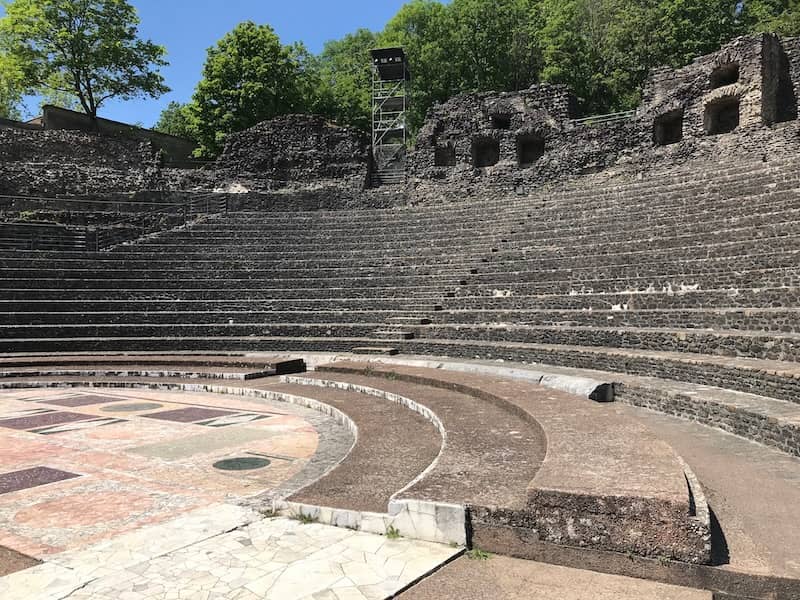
Old Lyon is protected by UNESCO, and a meander through its cobblestone streets is pleasant, especially if you can do it in the early evening when many of the day-trippers have gone. It being June, the sun shines high until late.
You’ll find plenty of secret passages, known as traboules, in the old part of the city, while the rest of these passages are hidden in Croix-Rousse, the area where the silk workers once lived.
One major attraction of Lyon is visual: throughout the city, you’ll find massive outdoor murals painted mostly on building walls, depicting various themes linked to the city. You can spend hours hunting them down while simultaneously getting to know the city.
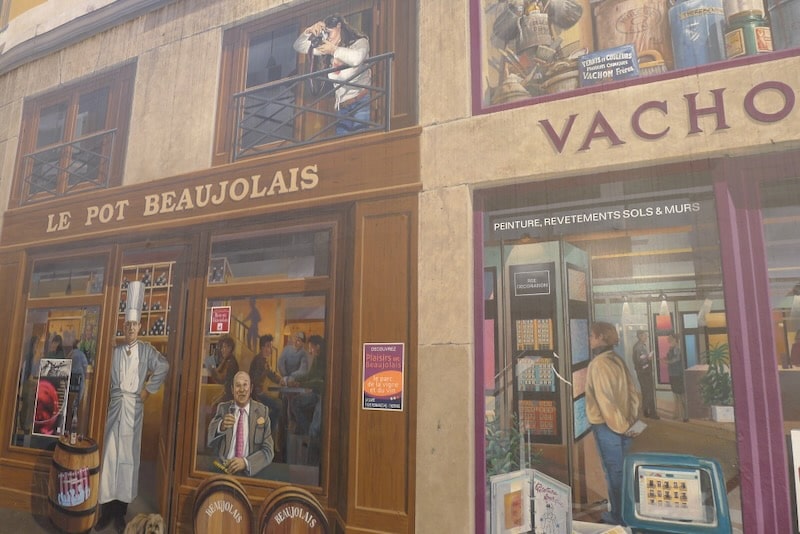
Finally, we should not forget that Lyon is often called the gastronomic capital of France, so when here, EAT, either by exploring on your own or taking one of the city's great food tours. The Lyon Street Food Festival is usually held in June, a fun event that attracts even Michelin-starred chefs whose foods you can taste for pennies.
The city’s outdoor markets overflow with local produce, and the bouchons, as traditional restaurants are called, serve plenty of authentic dishes (Lyon loves offal, but you don’t have to).
If you’re near the Part-Dieu train station, drop into the Halles Paul Bocuse, named after the famous chef who was born here, a luxury covered market with some of the best products in the city. (Here are some hotels near Part-Dieu train station.)
For a fabulous view of the city, take the little funicular train up Fourvière Hill to the basilica, whose interior deserves a visit and whose towering position over Lyon is captivating.
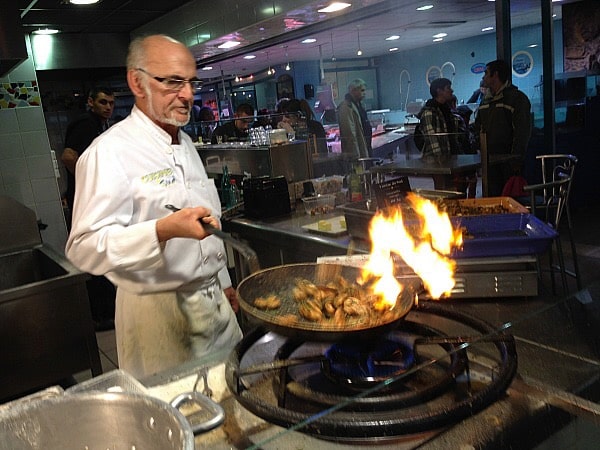
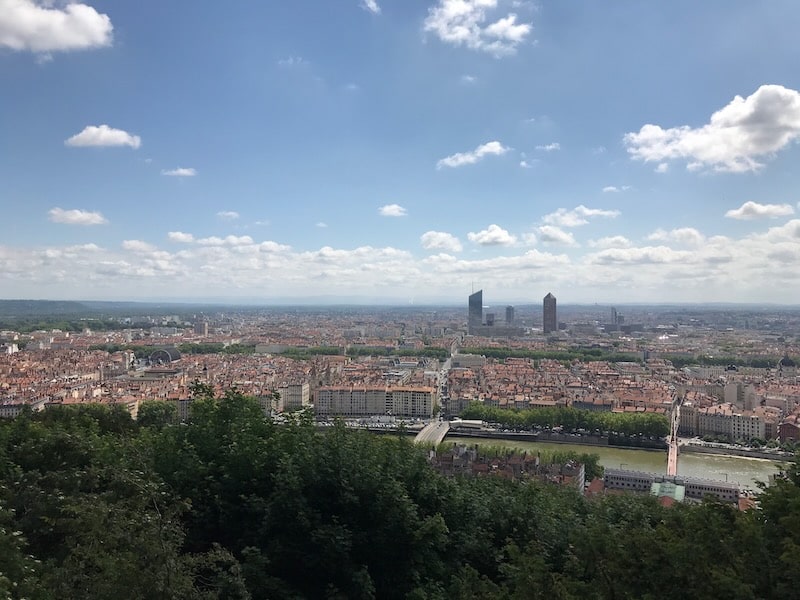
🌻 🌻 🌻
10. Paris
I’ve left the City of Lights for last, not because visiting Paris in June is so extraordinary (it is!) but because I was keen to have you discover other, equally stunning parts of France in early summer. I’ve known visitors who couldn’t tear themselves away from Paris in June…
So let us agree that Paris is beautiful any time of year, and much sought after, from the Eiffel Tower to its more offbeat corners. The full bloom of springtime stretches into summer in this season, and everything is green and fragrant, the dryness of summer still a bit down the line.
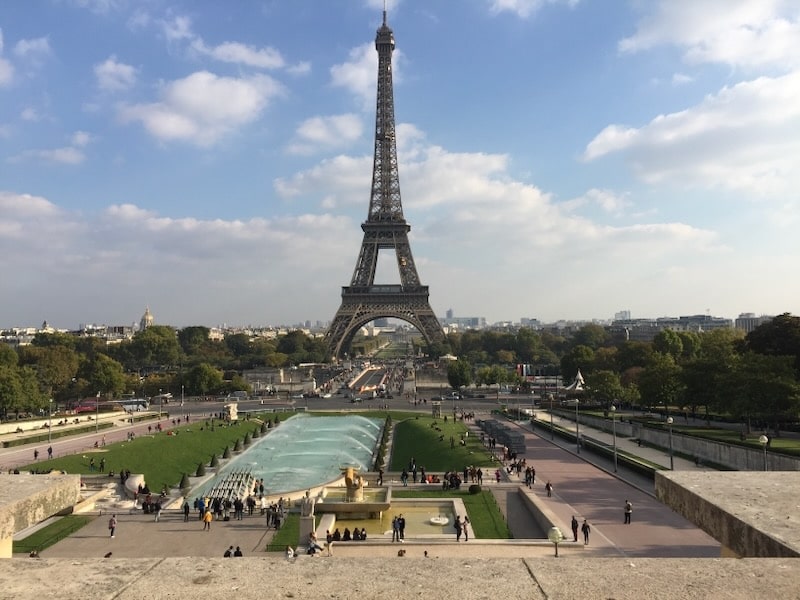
One of the best things to do in Paris in June is to be out of doors, in one of the city’s dozens of gardens, sitting and sipping a coffee in a café, or lazing along the riverbanks of the Seine – or, why not, taking one of the city’s famed river boat rides, either along the Seine or on the Canal Saint-Martin.
If you’re planning to eat out, my favorite environments are the Paris bouillons, those 19th-century restaurants originally created for market workers. They disappeared during the 20th century but have now made a stunning comeback, for their food, their prices, and their decor.
Paris, frankly, is a year-round city, beautiful in June, but Paris in fall is just as gorgeous, in a different way. Even Paris in winter has its attractions. The one season I tend to avoid Paris is in summer, when prices are high, long lines are everywhere, the heat can be oppressive, and Parisians, who know all this, have escaped to the mountains or seashore. In June, you’ll still have crowds, but they will be manageable. And the weather will be superb.
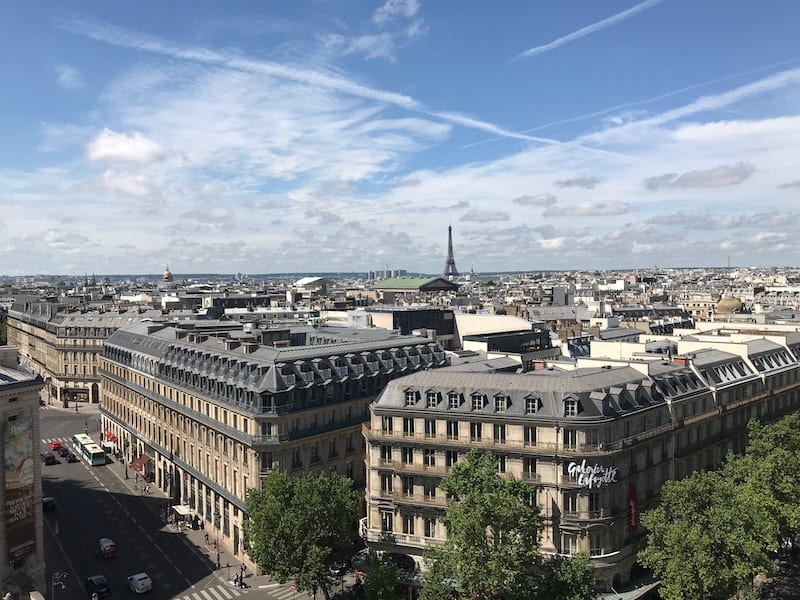
🌻 🌻 🌻
A few bonus places to visit in France in June
- Corsica, also called the “Island of Beauty”, is the hometown of Napoleon Bonaparte, but is also filled with fabulous hiking trails, crystalline beaches, and charming towns filled with culture and history - and excellent local cuisine. (If you're a hiker, here are 11 more hiking trails in France.)
- Brittany, for its fabulous islands and rocky coastline, its intriguing legends, its historical cities and their fortifications, and the Pink Granite coast.
- Normandy, often rainy during other times of year, positively blooms in June, and there's so much to do, from visiting Rouen to exploring the D-Day beaches to discovering the unique Mont Saint-Michel (and of course, Monet's home at Giverny).
- The Drôme, the gateway to Provence, is covered in lavender in June – you’ll also appreciate the olives of Nyons and the Château de Grignan, home of Mme de Sévigné (a prolific letter-writer in the time of Louis XIV).
- Alsace, in northeastern France near the German border, where you can follow the Wine Route on a tour - it’s better than driving because you can actually sample the wine without worrying about going over the limit (between 1-2 glasses of wine, depending on your size).
- The Jura mountains, across the Rhône River from the French Alps, is cool and shady in June, ideal for long-distance hikers (and lovers of cheese - there are many cheese manufacturers in these picturesque mountains).
- Bordeaux, with cool breezes blowing in from the Garonne River, is a delight in June – which, for amateurs, is also when the hugely popular Festival Bordeaux Fête le Vin takes place.
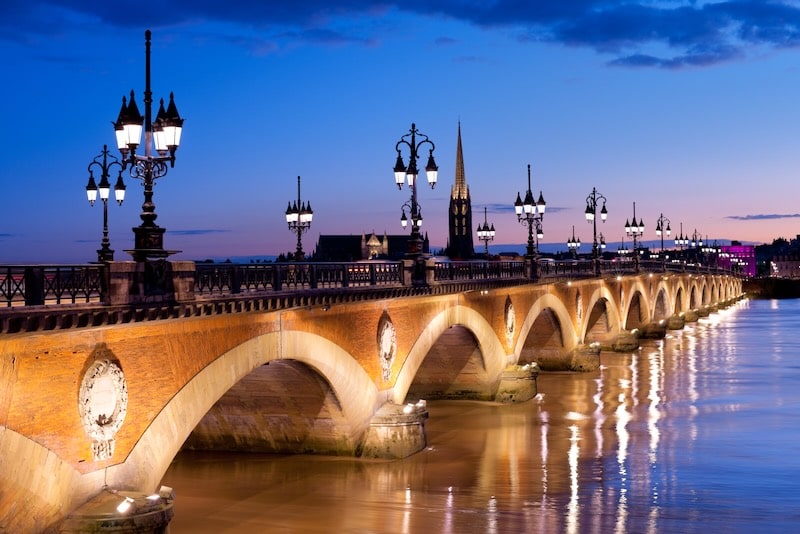
Festivals and events in France in June
June is a special month in the France calendar, with a massive number of festivals in all regions of the country. Here are a few of the highlights.
In Paris in June, you have the French Open, if you’re a tennis fan; the Paris Jazz Festival’s summer concerts in the Parc Floral usually start at the end of June; Paris Gay Pride, a parade with a 40-year history; or the Chopin Festival in the Orangerie.
In northern France, every June celebrates the D-Day landings that led to France’s liberation at the end of World War II with fireworks on Omaha Beach, and the Festival de la Côte d'Opale features well-known French artists.
In Lyon in June, don’t miss the Nuits de Fourvieres, a huge stage arts festival with everything from dance to theater to circus.
In June, in Central France, the wonderful International Garden Festival at the Château de Chaumont-sur-Loire, one of my favorites (the themes change every year); in Annonay, the Hot Air Balloon Festival celebrates the city in which the hot air balloon was invented.
In Corsica, June welcomes the Corsica Raid Adventure across the island and the Cavall’in Festa for horse-lovers.
In southern France in June, the international Festival d’Avignon features all kinds of theater and takes place in June or July; the Fete de la Saint-Pierre along the coast celebrates fishermen with music, boats and seafood; the Sails of Antibes with its traditional sailboats.
Across France in June, the Fete de la Musique (on 21 June) celebrates all music everywhere — in the streets, in cafes and restaurants, in parks and concert halls. And the Tour de France, which is usually in July, in some years starts in June.
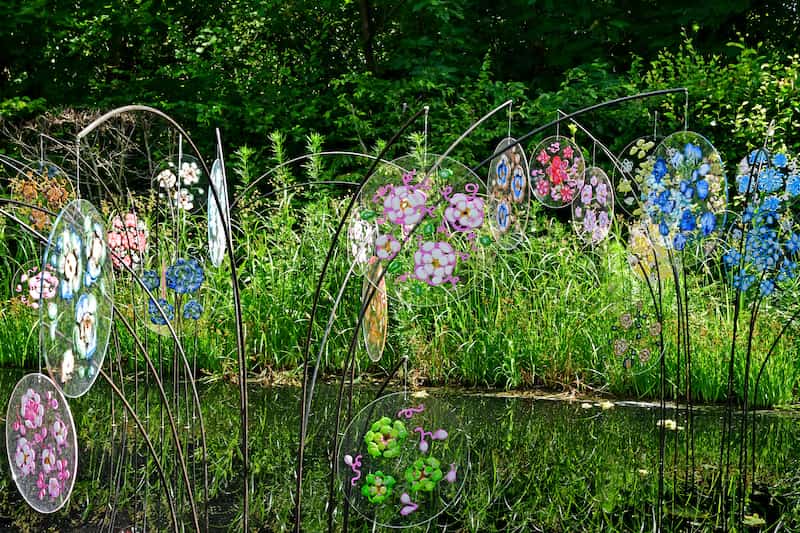
Have I convinced you to visit France in June?
I hope so!
May and June are my favorite months in France, and as I write this, June is around the corner and the land and wildlife around me – I live in the countryside – are extraordinarily rich and vibrant.
The weather in June in France brings out some of the country’s best, with blooms and fresh produce and simple physical beauty.
In June, everyone is smiling: the weather is glorious, and summer is around the corner. I feel the same.
FAQ France in June
Is June a good time to visit France?
Is June a good time to visit France?
June is a wonderful time to visit France. The heat of summer hasn't arrived yet, nor have the vacationing crowds.
Is June a good time to go to Paris?
Is June a good time to go to Paris?
June is one of the best months of the year to visit Paris. The weather is outstanding, but the city is also less crowded than it will be come July.
Is the South of France hot in June?
Is the South of France hot in June?
Warm but not too hot. Of course temperatures vary and can rise, but on average, temperatures will stay between 20℃-25℃ during the day.
Is it rainy in France in June?
Is it rainy in France in June?
France is not rainy in June, although it could rain a few days a month, perhaps 7-8, depending on which part of France you're in. But as always with weather, no guarantees...
Can you swim in France in June?
Can you swim in France in June?
You certainly can swim in the Mediterranean in June. The Atlantic, however, will be colder, although plenty of people also swim on that coast.
Did you enjoy this article? I'd love if you shared it!
